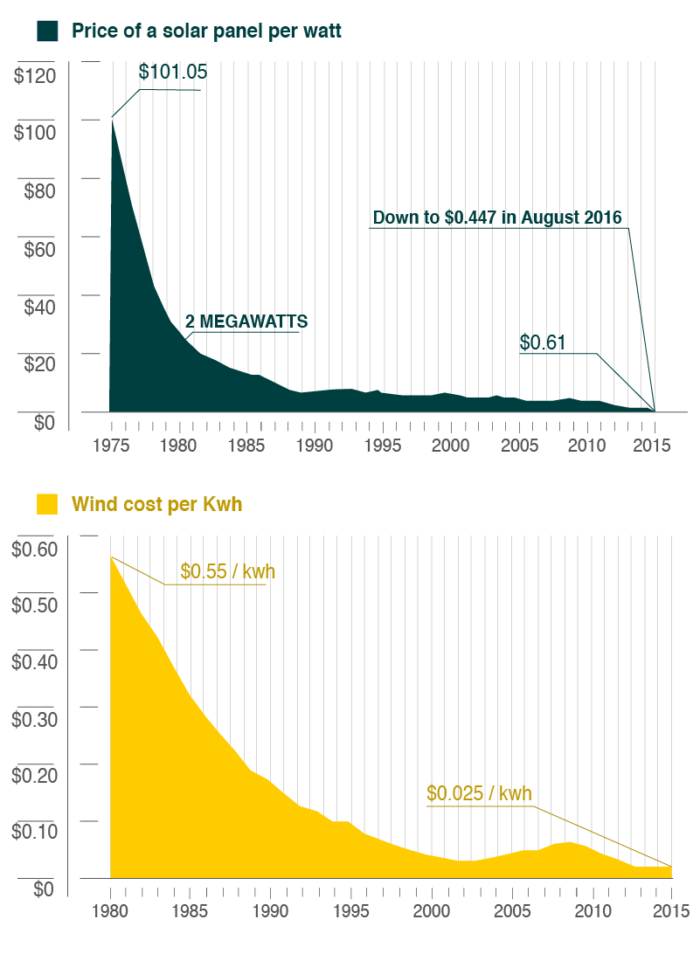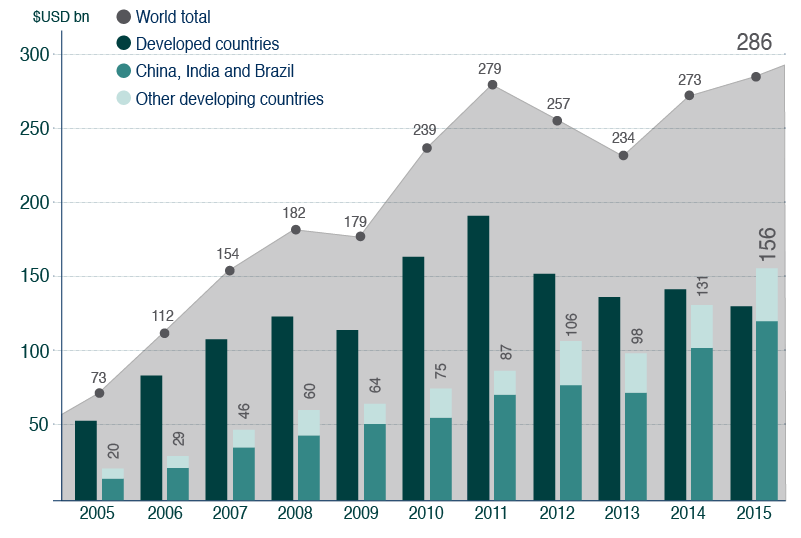The global transition to clean, renewable energy is well underway with remarkable breakthroughs in sustainable energy production occurring every single day. Wind power capacity has grown more than 20% every year over the last decade, the price of solar power has declined by nearly 100% since 1972 and over 70 governments around the world have now introduced legislation that encourages investment in these technologies. For the first time in over a century, we have experienced three consecutive years of declining carbon emissions amid economic growth, proving the profitability of environmental responsibility.
Today, burning fossil fuels account for 80% of the worlds total energy demand. This has led to 90 million tons of carbon dioxide (CO2) being spewed into the atmosphere every 24 hours. Pledges made in the UN COP21 Climate Summit have undeniably given impetus to the move towards a lower-carbon and more efficient energy system and have so far enabled most of the world’s major emitting nations to decrease their carbon emissions over the last year. What’s more, the International Energy Agency has drastically revised its forecast for renewables upward over the next five years. Why? Solar grew faster than any other source of fuel for the first time ever in 2016.
Solar capacity grew by 50% to reach more than 74 gigawatts (GW) last year. This was the first time solar additions rose faster than any other fuel. This trend is occurring across renewables. The IEA expects global renewable electricity capacity to rise by more than 920 GW, or 43%, by 2022, due to support policies for low-carbon energy and cost reductions for solar and wind. This projected growth is 12% higher than forecasts published last year. Net additions to renewable energy capacity, including hydropower, solar, wind, bioenergy, wave and tidal, set another world record, growing by 165 GW, (6% more than in 2015). Renewables will grow to 1,000 GW by 2022, which equals about half of the current global capacity in coal power, which took 80 years to build. Renewables will account for nearly a third of the global energy mix in five years’ time, compared to the 24% forecast last year.
.
.Falling Prices of Solar and Wind Technologies
Source: Clean Technica & Ramez Naam (2016)
..
This is great news, especially when you consider that 90 million tons of carbon dioxide (CO2) being spewed into the atmosphere every 24 hours from fossil fuel energy generation. Global carbon emissions will have to peak by 2020 and then reduce by 3% every year if we are to reach zero emissions by the end of the century. This level of emission reduction is what is required to limit temperature increases to 2C above pre-industrial levels. CO2 emissions from China fell 0.3% in 2016. US CO2 emissions fell 2% and Russia’s by 2.1%, with the EU flat. Emissions from the United Kingdom tumbled by 6.4%. Of the top five emitters, only India’s rose, by 4.7%. Significant increases were also seen in Indonesia, Malaysia, the Philippines, Turkey, and Ukraine.
Brazil, as the world’s seventh biggest greenhouse gas polluter, said it would cut its emissions by 37% by 2025 from 2005 levels by reducing deforestation and boosting the share of renewable sources in its energy mix. However, the country has already achieved significant emission reductions, primarily due to increased efforts in reducing deforestation of the Amazon rainforest.We must reach peak emissions as soon as possible and then achieve a rapid decline soon afterward. There are clear signs that the much-needed transition in global energy supply is underway, but not yet at a pace that leads to a long-lasting reversal of high CO2 emissions. In order to achieve a low carbon future, we must focus on renewable technologies that harness power in a clean and sustainable way. Innovations in the wind, solar and hydropower generation will undoubtedly lead the way.
.
Global New Investment In Renewables, By Region
Source: Raconteur (2017)
.
.At Primal Group, we are supporting the trends towards renewable and sustainable energy sources. We have developed our own Zero Carbon Footprint Plan, with our ultimate objective to utilize 100% clean and renewable energy on our agricultural projects while reducing demand for fossil fuel energy generation. While ambitious, we plan to remove our reliance on the Brazilian National Grid for our energy needs, offering a sustainable way to fulfill our energy requirements necessary for running a large-scale agricultural project through renewable sources. We have successfully implemented the first phase of this plan with our solar panel project that has the potential to generate up to 42.3-megawatt hours per year at full capacity, around 20% of our annual energy consumption. Both environmentally friendly and financially beneficial, this is a prime example of how the intersection of sustainability and business makes commercial sense and will continue to do so in the future.

